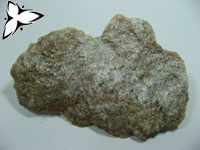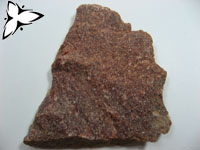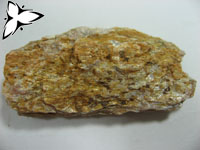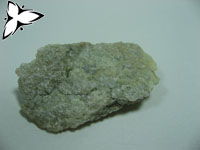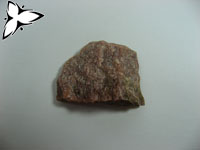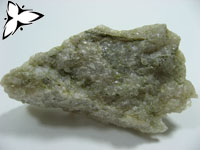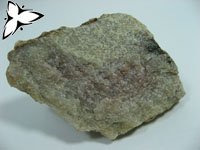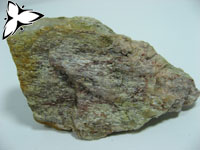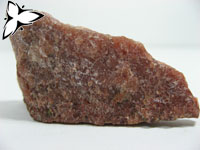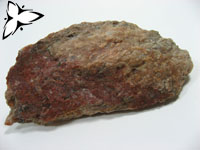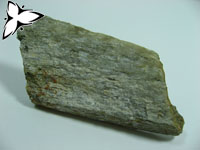![]()
Quartzite is a hard, non-foliated metamorphic rock which was originally sandstone. Sandstone is converted into quartzite through heating and pressure usually related to tectonic compression within orogenic belts. Pure quartzite is usually white to gray, though quartzites often occur in various shades of pink and red due to varying amounts of iron oxide. Other colors, such as yellow and orange, are due to other mineral impurities. In the United States, formations of quartzite can be found in some parts of Pennsylvania, eastern South Dakota, Central Texas, southwest Minnesota, Devil's Lake State Park in the Baraboo Hills in Wisconsin, the Wasatch Range in Utah, near Salt Lake City Utah, and as resistant ridges in the Appalachiansand other mountain regions. Quartzite is also found in the Morenci Copper Mine in Arizona. The town of Quartzsite in western Arizona derives its name from the quartzites in the nearby mountains in both Arizona and Southeastern California. A glassy vitreous quartzite has been described from the Belt Supergroup in the Coeur d’Alene district of northern Idaho. In Canada, the La Cloche Mountains in Ontario are composed primarily of white quartzite. In the United Kingdom, a craggy ridge of quartzite called the Stiperstones runs parallel with the Pontesford-Linley fault, 6 km north-west of the Long Mynd in south Shropshire. Also to be found in England are the Cambrian "Wrekin quartizite" , and the Cambrian "Hartshill quartzite". In Wales, Holyhead mountain and most of Holy island off Anglesey sport excellent Precambrian quartzite crags and cliffs. In the Scottish Highlands, several mountains (e.g. Foinaven, Arkle) composed of Cambrian quartzite can be found in the far north-west Moine Thrust Belt running in a narrow band from Loch Eriboll in a south-westerly direction to Skye.
![]()
Within the metaphysical realm of rocks, quartzite stabilizes positive changes by anchoring them in the fabric of your physical and subtle bodies. It helps prevent you from slipping back to your old state after you undergo any uplifting change, such as a healing or spiritual experience.
Please note that MIROFOSS does not suggest in any way that rocks should be used in place of proper medical and psychological care. This information is provided here as a reference only.
![]() Due to the hardness and angular shape of quartzite, crushed quartzite is often used as railway ballast. Quartzite is a decorative stone and may be used to cover walls, as roofing tiles, as flooring, and stair steps. Crushed quartzite is sometimes used in road construction. High purity quartzite is used to produce ferrosilicon, industrial silica sand, silicon and silicon carbide. During the Stone Age quartzite was used as an inferior alternative to flint.
Due to the hardness and angular shape of quartzite, crushed quartzite is often used as railway ballast. Quartzite is a decorative stone and may be used to cover walls, as roofing tiles, as flooring, and stair steps. Crushed quartzite is sometimes used in road construction. High purity quartzite is used to produce ferrosilicon, industrial silica sand, silicon and silicon carbide. During the Stone Age quartzite was used as an inferior alternative to flint.
![]()
Quartzite occurs in high pressure and deep burials of sandstone and chert.
![]()
When sandstone is metamorphosed to quartzite, the individual quartz grains recrystallize along with the former cementing material to form an interlocking mosaic of quartz crystals. Most ,or all, of the original texture and sedimentary structures of the sandstone are erased by the metamorphism. Minor amounts of the former cementing materials such as iron oxide, silica, carbonate, and clay, often migrate during recrystallization and metamorphosis. This causes streaks and lenses to form within the quartzite. Orthoquartzite is a very pure quartz sandstone composed of usually well rounded quartz grains cemented by silica. Although few fossils are normally present, the original texture and sedimentary structures are preserved. The term is often misused, and should be used for only tightly-cemented metamorphic quartzites, not quartz-cemented quartz arenites. The typical distinction between the two (since each is a gradation into the other) is a proper quartzite is so highly cemented, diagentically altered, and metamorphosed that it will fracture and break across grain boundaries, not around them. Quartzite is very resistant to chemical weathering and often forms ridges and resistant hilltops. The nearly pure silica content of the rock provides little for soil, therefore, the quartzite ridges are often bare or covered only with a very thin layer of soil and, if any, little vegetation.
![]()
| Texture | Granular | |
| Colour(s) | White, Brown, Red, Violet, Yellow | |
| Grain Size | Medium | |
| Mohs Hardness | 7 (Approximately) | |
| Luminescence | Non-fluorescent | |
| Lustre | Vitreous | |
| Streak | White |
![]()
No known health risks have been associated with quartzite. However ingestion of quartzite, as with other naturally occurring rocks, is not recommended.
![]()
The following image shows the mineral components of quartzite:

![]()

![]()
The rock quartzite can be translated into the following select languages:
| Arabic | الكوارتز | Bulgarian | кварцити | Chinese (Sim) | 石英岩 |
| Croatian | kvarcit | Czech | křemene | Danish | kvartsit |
| Dutch | kwartsiet | Esperanto | kvartita | Estonian | kvartsiit |
| Finnish | kvartsiitti | French | German | quarzit | |
| Greek | χαλαζίτης | Hebrew | קוורציט | Hungarian | kvarcit |
| Italian | Japanese | 珪岩 | Korean | 규암 | |
| Latin | Lithuanian | kvarcitas | Norwegian | kvartsitt | |
| Persian | کوارتزیت | Polish | kwarcyt | Portuguese | quartzito |
| Romanian | cuarțit | Russian | кварцит | Slovak | kremenec |
| Spanish | cuarcita | Swedish | kvartsit | Tagalog | kuwarts |
| Turkish | kuvarsit | Ukrainian | кварцит | Vietnamese | thạch anh |
![]()
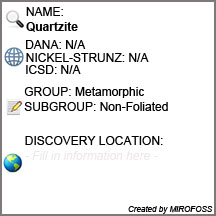 |
The MIROFOSS database offers free printable geological identification tags for personal and non-profit use. These tags can be used to properly identify mineral samples in your collection. -Click here- to download a full size jpeg image for a quartzite identification tag; which can be printed on paper or used with a plastic laser printer. |
 |
What's this? What can I do with it? |
![]()
| Industrial Applications | Krukowski, Stanley T. (2006). "Specialty Silica Materials". In Jessica Elzea Kogel; Nikhil C. Trivedi; James M. Barker; Stanley T. Krukowski. Industrial minerals & rocks: commodities, markets, and uses (7 ed.). Society for Mining, Metallurgy, and Exploration (U.S.). p. 842. ISBN 0-87335-233-5. |
| Background | Essentials of Geology, 3rd Edition, Stephen Marshak, p 182 |
| Petrology | John Blunden, (1975), The mineral resources of Britain: a study in exploitation and planning, p. 281. |
| Background | Journal of Sedimentary Petrology 44 (1): 264–265. |
| Physical Identification | Mineral Information Institute. Retrieved 2012-09-09. |
| September 30, 2013 | Page Creation Date |
| September 19, 2017 | The last time this page was updated |
| ©2019 MIROFOSS™ Foundation | |
 |
|

